2016 NISSAN LEAF wheel
[x] Cancel search: wheelPage 10 of 437
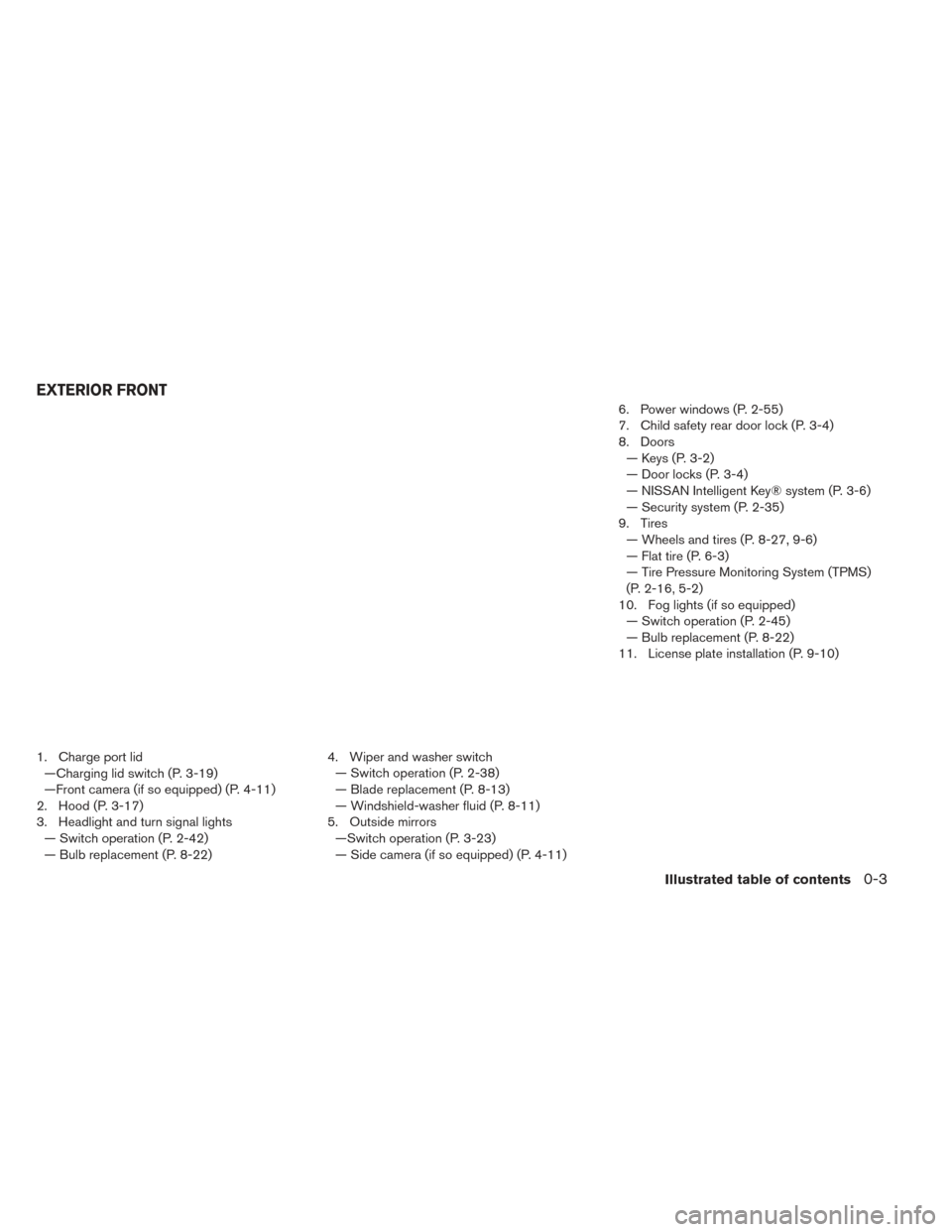
1. Charge port lid—Charging lid switch (P. 3-19)
—Front camera (if so equipped) (P. 4-11)
2. Hood (P. 3-17)
3. Headlight and turn signal lights — Switch operation (P. 2-42)
— Bulb replacement (P. 8-22) 4. Wiper and washer switch
— Switch operation (P. 2-38)
— Blade replacement (P. 8-13)
— Windshield-washer fluid (P. 8-11)
5. Outside mirrors —Switch operation (P. 3-23)
— Side camera (if so equipped) (P. 4-11) 6. Power windows (P. 2-55)
7. Child safety rear door lock (P. 3-4)
8. Doors
— Keys (P. 3-2)
— Door locks (P. 3-4)
— NISSAN Intelligent Key® system (P. 3-6)
— Security system (P. 2-35)
9. Tires — Wheels and tires (P. 8-27, 9-6)
— Flat tire (P. 6-3)
— Tire Pressure Monitoring System (TPMS)
(P. 2-16, 5-2)
10. Fog lights (if so equipped) — Switch operation (P. 2-45)
— Bulb replacement (P. 8-22)
11. License plate installation (P. 9-10)
EXTERIOR FRONT
Illustrated table of contents0-3
Page 13 of 437
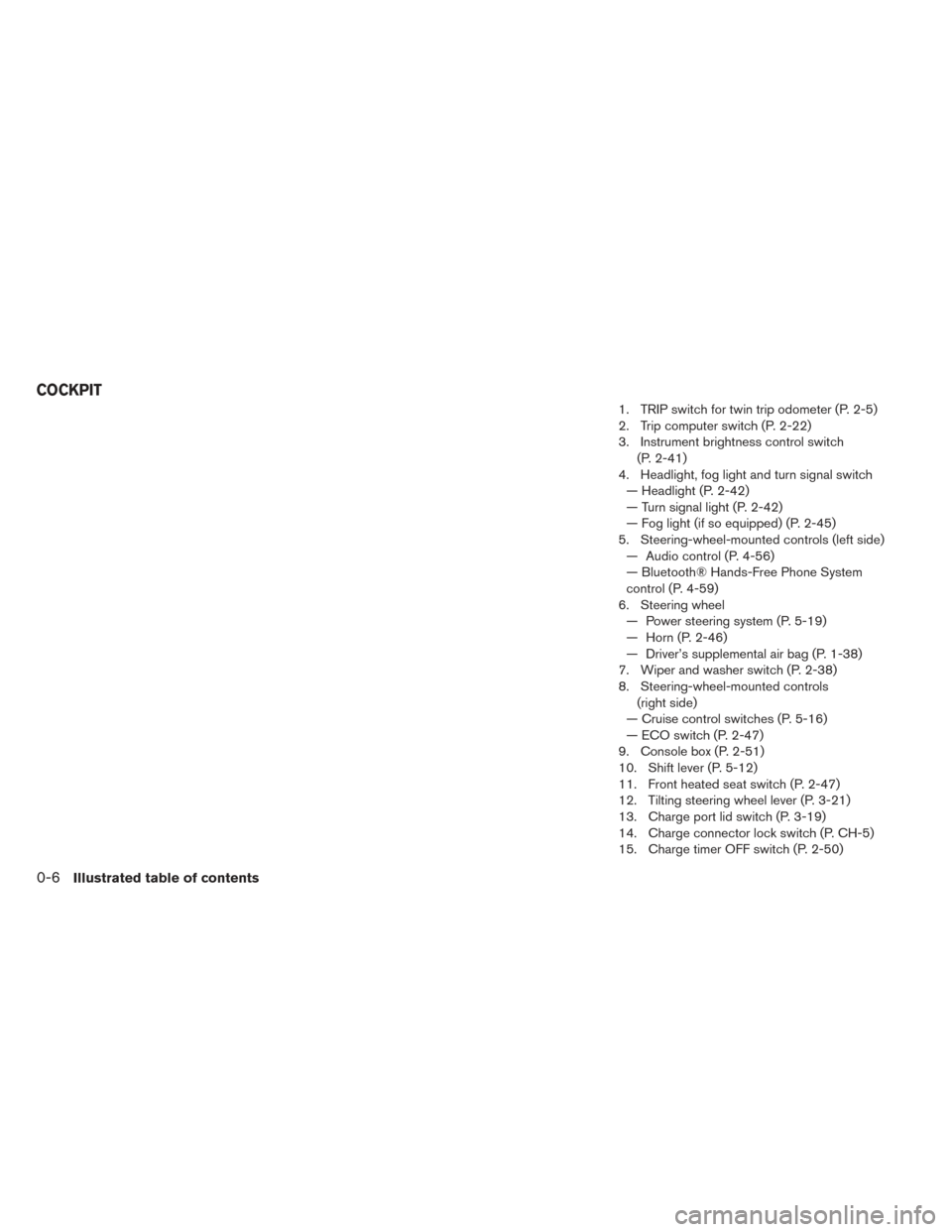
1. TRIP switch for twin trip odometer (P. 2-5)
2. Trip computer switch (P. 2-22)
3. Instrument brightness control switch(P. 2-41)
4. Headlight, fog light and turn signal switch — Headlight (P. 2-42)
— Turn signal light (P. 2-42)
— Fog light (if so equipped) (P. 2-45)
5. Steering-wheel-mounted controls (left side) — Audio control (P. 4-56)
— Bluetooth® Hands-Free Phone System
control (P. 4-59)
6. Steering wheel — Power steering system (P. 5-19)
— Horn (P. 2-46)
— Driver’s supplemental air bag (P. 1-38)
7. Wiper and washer switch (P. 2-38)
8. Steering-wheel-mounted controls (right side)
— Cruise control switches (P. 5-16)
— ECO switch (P. 2-47)
9. Console box (P. 2-51)
10. Shift lever (P. 5-12)
11. Front heated seat switch (P. 2-47)
12. Tilting steering wheel lever (P. 3-21)
13. Charge port lid switch (P. 3-19)
14. Charge connector lock switch (P. CH-5)
15. Charge timer OFF switch (P. 2-50)
COCKPIT
0-6Illustrated table of contents
Page 14 of 437
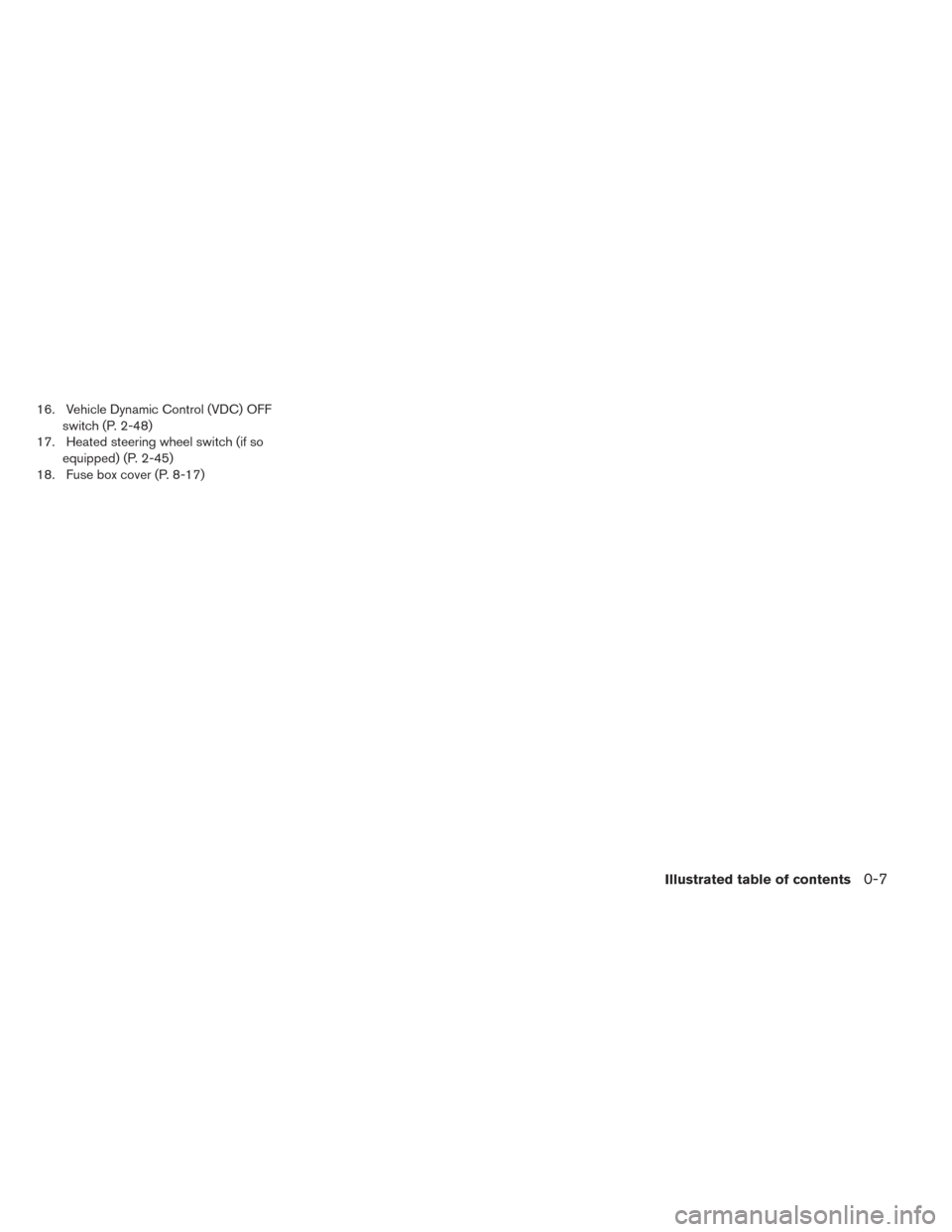
16. Vehicle Dynamic Control (VDC) OFFswitch (P. 2-48)
17. Heated steering wheel switch (if so equipped) (P. 2-45)
18. Fuse box cover (P. 8-17)
Illustrated table of contents0-7
Page 27 of 437
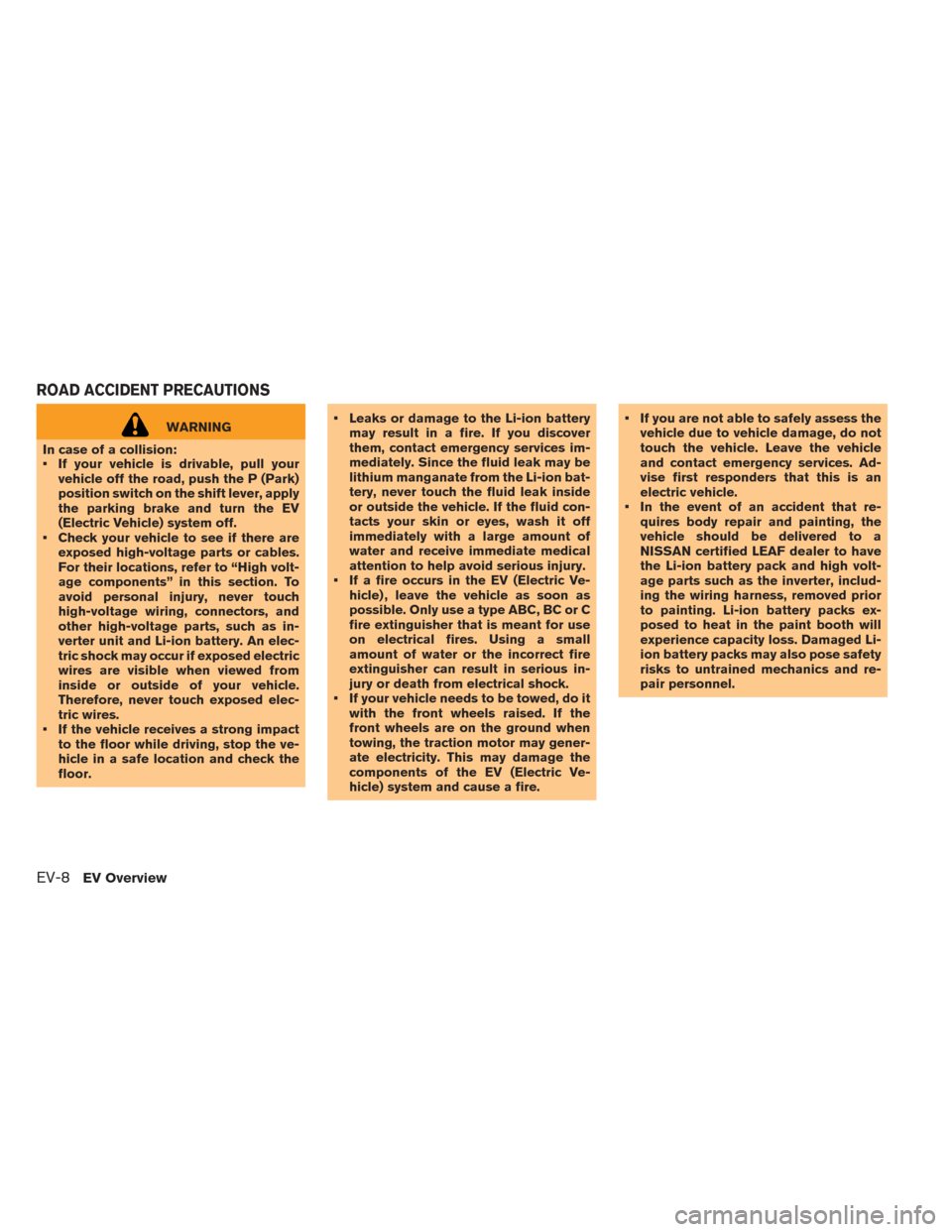
WARNING
In case of a collision:
• If your vehicle is drivable, pull your vehicle off the road, push the P (Park)
position switch on the shift lever, apply
the parking brake and turn the EV
(Electric Vehicle) system off.
• Check your vehicle to see if there are exposed high-voltage parts or cables.
For their locations, refer to “High volt-
age components” in this section. To
avoid personal injury, never touch
high-voltage wiring, connectors, and
other high-voltage parts, such as in-
verter unit and Li-ion battery. An elec-
tric shock may occur if exposed electric
wires are visible when viewed from
inside or outside of your vehicle.
Therefore, never touch exposed elec-
tric wires.
• If the vehicle receives a strong impact to the floor while driving, stop the ve-
hicle in a safe location and check the
floor. • Leaks or damage to the Li-ion battery
may result in a fire. If you discover
them, contact emergency services im-
mediately. Since the fluid leak may be
lithium manganate from the Li-ion bat-
tery, never touch the fluid leak inside
or outside the vehicle. If the fluid con-
tacts your skin or eyes, wash it off
immediately with a large amount of
water and receive immediate medical
attention to help avoid serious injury.
• If a fire occurs in the EV (Electric Ve- hicle) , leave the vehicle as soon as
possible. Only use a type ABC, BC or C
fire extinguisher that is meant for use
on electrical fires. Using a small
amount of water or the incorrect fire
extinguisher can result in serious in-
jury or death from electrical shock.
• If your vehicle needs to be towed, do it with the front wheels raised. If the
front wheels are on the ground when
towing, the traction motor may gener-
ate electricity. This may damage the
components of the EV (Electric Ve-
hicle) system and cause a fire. • If you are not able to safely assess the
vehicle due to vehicle damage, do not
touch the vehicle. Leave the vehicle
and contact emergency services. Ad-
vise first responders that this is an
electric vehicle.
• In the event of an accident that re- quires body repair and painting, the
vehicle should be delivered to a
NISSAN certified LEAF dealer to have
the Li-ion battery pack and high volt-
age parts such as the inverter, includ-
ing the wiring harness, removed prior
to painting. Li-ion battery packs ex-
posed to heat in the paint booth will
experience capacity loss. Damaged Li-
ion battery packs may also pose safety
risks to untrained mechanics and re-
pair personnel.
ROAD ACCIDENT PRECAUTIONS
EV-8EV Overview
Page 42 of 437
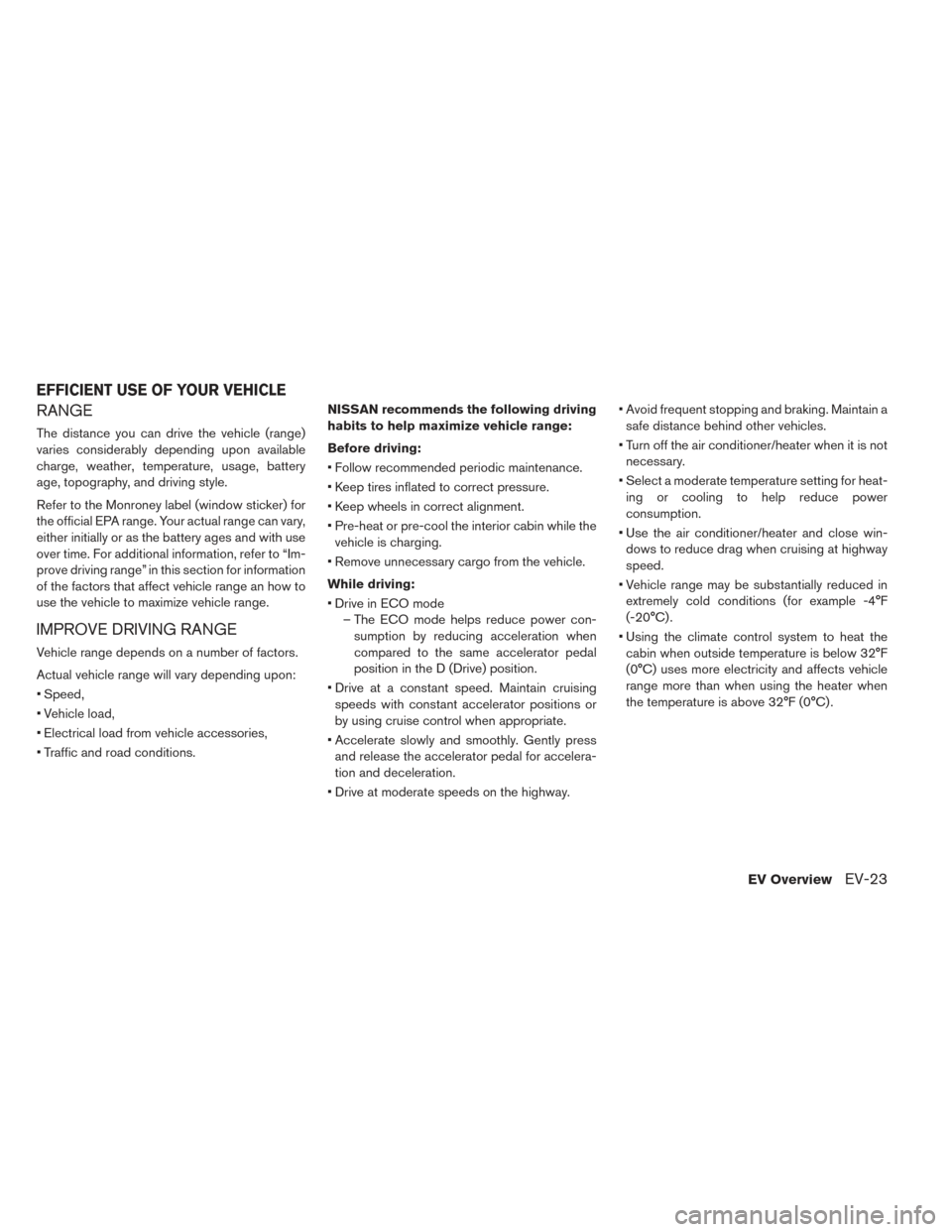
RANGE
The distance you can drive the vehicle (range)
varies considerably depending upon available
charge, weather, temperature, usage, battery
age, topography, and driving style.
Refer to the Monroney label (window sticker) for
the official EPA range. Your actual range can vary,
either initially or as the battery ages and with use
over time. For additional information, refer to “Im-
prove driving range” in this section for information
of the factors that affect vehicle range an how to
use the vehicle to maximize vehicle range.
IMPROVE DRIVING RANGE
Vehicle range depends on a number of factors.
Actual vehicle range will vary depending upon:
• Speed,
• Vehicle load,
• Electrical load from vehicle accessories,
• Traffic and road conditions.NISSAN recommends the following driving
habits to help maximize vehicle range:
Before driving:
• Follow recommended periodic maintenance.
• Keep tires inflated to correct pressure.
• Keep wheels in correct alignment.
• Pre-heat or pre-cool the interior cabin while the
vehicle is charging.
• Remove unnecessary cargo from the vehicle.
While driving:
• Drive in ECO mode – The ECO mode helps reduce power con-sumption by reducing acceleration when
compared to the same accelerator pedal
position in the D (Drive) position.
• Drive at a constant speed. Maintain cruising speeds with constant accelerator positions or
by using cruise control when appropriate.
• Accelerate slowly and smoothly. Gently press and release the accelerator pedal for accelera-
tion and deceleration.
• Drive at moderate speeds on the highway. • Avoid frequent stopping and braking. Maintain a
safe distance behind other vehicles.
• Turn off the air conditioner/heater when it is not necessary.
• Select a moderate temperature setting for heat- ing or cooling to help reduce power
consumption.
• Use the air conditioner/heater and close win- dows to reduce drag when cruising at highway
speed.
• Vehicle range may be substantially reduced in extremely cold conditions (for example -4°F
(-20°C) .
• Using the climate control system to heat the cabin when outside temperature is below 32°F
(0°C) uses more electricity and affects vehicle
range more than when using the heater when
the temperature is above 32°F (0°C) .
EFFICIENT USE OF YOUR VEHICLE
EV OverviewEV-23
Page 122 of 437
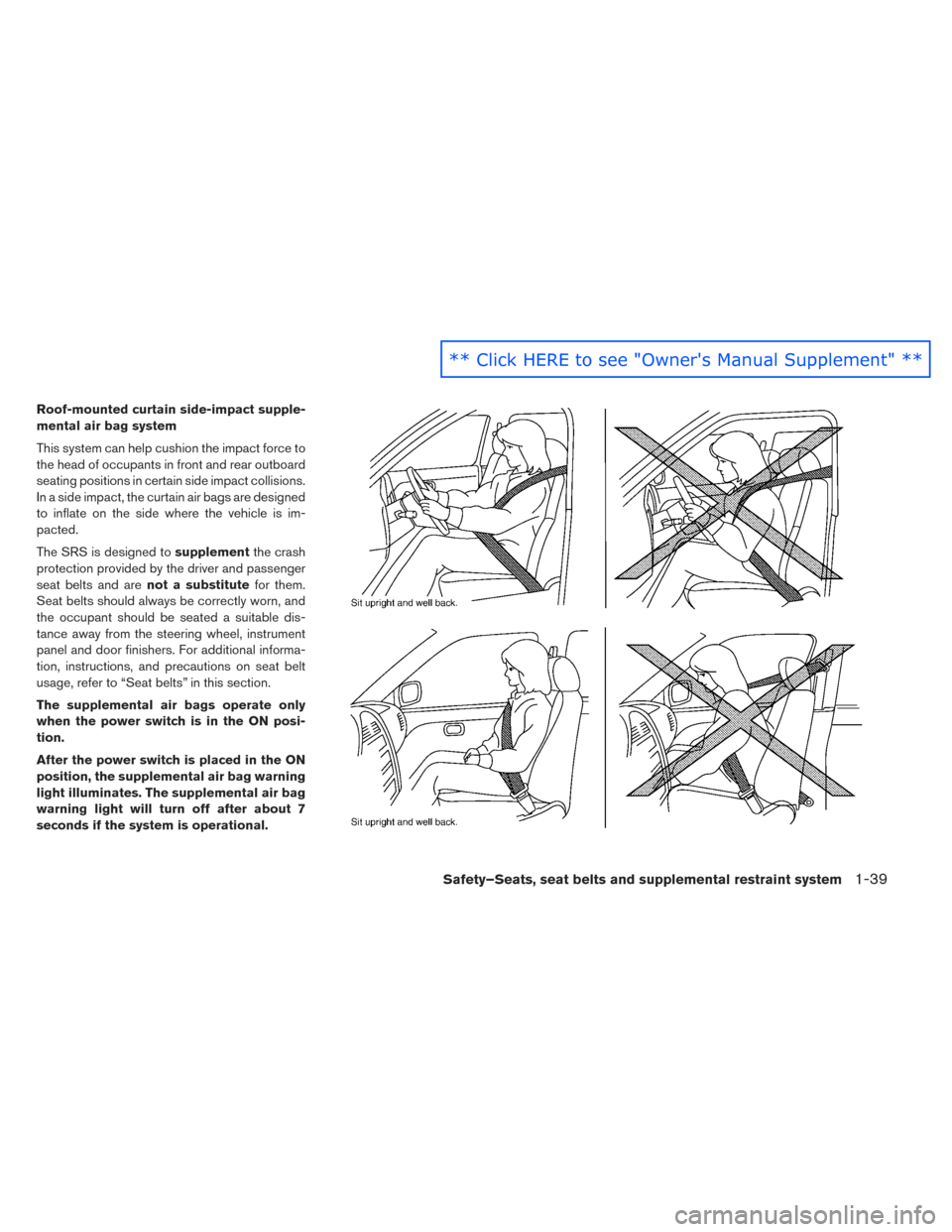
Roof-mounted curtain side-impact supple-
mental air bag system
This system can help cushion the impact force to
the head of occupants in front and rear outboard
seating positions in certain side impact collisions.
In a side impact, the curtain air bags are designed
to inflate on the side where the vehicle is im-
pacted.
The SRS is designed tosupplementthe crash
protection provided by the driver and passenger
seat belts and are not a substitutefor them.
Seat belts should always be correctly worn, and
the occupant should be seated a suitable dis-
tance away from the steering wheel, instrument
panel and door finishers. For additional informa-
tion, instructions, and precautions on seat belt
usage, refer to “Seat belts” in this section.
The supplemental air bags operate only
when the power switch is in the ON posi-
tion.
After the power switch is placed in the ON
position, the supplemental air bag warning
light illuminates. The supplemental air bag
warning light will turn off after about 7
seconds if the system is operational.
Safety–Seats, seat belts and supplemental restraint system1-39
** Click HERE to see "Owner's Manual Supplement" **
Page 123 of 437
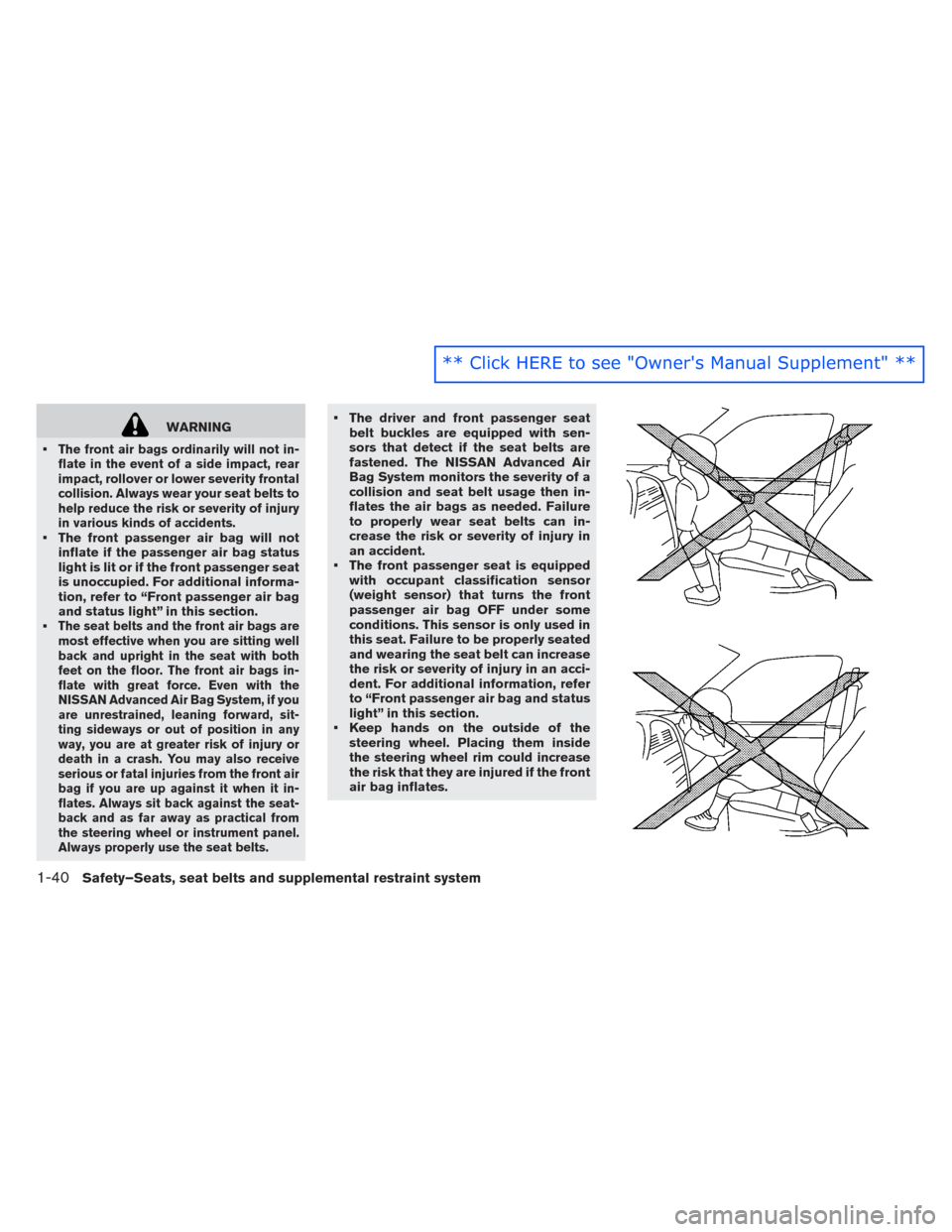
WARNING
•
The front air bags ordinarily will not in-
flate in the event of a side impact, rear
impact, rollover or lower severity frontal
collision. Always wear your seat belts to
help reduce the risk or severity of injury
in various kinds of accidents.
• The front passenger air bag will not inflate if the passenger air bag status
light is lit or if the front passenger seat
is unoccupied. For additional informa-
tion, refer to “Front passenger air bag
and status light” in this section.
•
The seat belts and the front air bags are
most effective when you are sitting well
back and upright in the seat with both
feet on the floor. The front air bags in-
flate with great force. Even with the
NISSAN Advanced Air Bag System, if you
are unrestrained, leaning forward, sit-
ting sideways or out of position in any
way, you are at greater risk of injury or
death in a crash. You may also receive
serious or fatal injuries from the front air
bag if you are up against it when it in-
flates. Always sit back against the seat-
back and as far away as practical from
the steering wheel or instrument panel.
Always properly use the seat belts.
• The driver and front passenger seat belt buckles are equipped with sen-
sors that detect if the seat belts are
fastened. The NISSAN Advanced Air
Bag System monitors the severity of a
collision and seat belt usage then in-
flates the air bags as needed. Failure
to properly wear seat belts can in-
crease the risk or severity of injury in
an accident.
• The front passenger seat is equipped with occupant classification sensor
(weight sensor) that turns the front
passenger air bag OFF under some
conditions. This sensor is only used in
this seat. Failure to be properly seated
and wearing the seat belt can increase
the risk or severity of injury in an acci-
dent. For additional information, refer
to “Front passenger air bag and status
light” in this section.
• Keep hands on the outside of the steering wheel. Placing them inside
the steering wheel rim could increase
the risk that they are injured if the front
air bag inflates.
1-40Safety–Seats, seat belts and supplemental restraint system
** Click HERE to see "Owner's Manual Supplement" **
Page 127 of 437
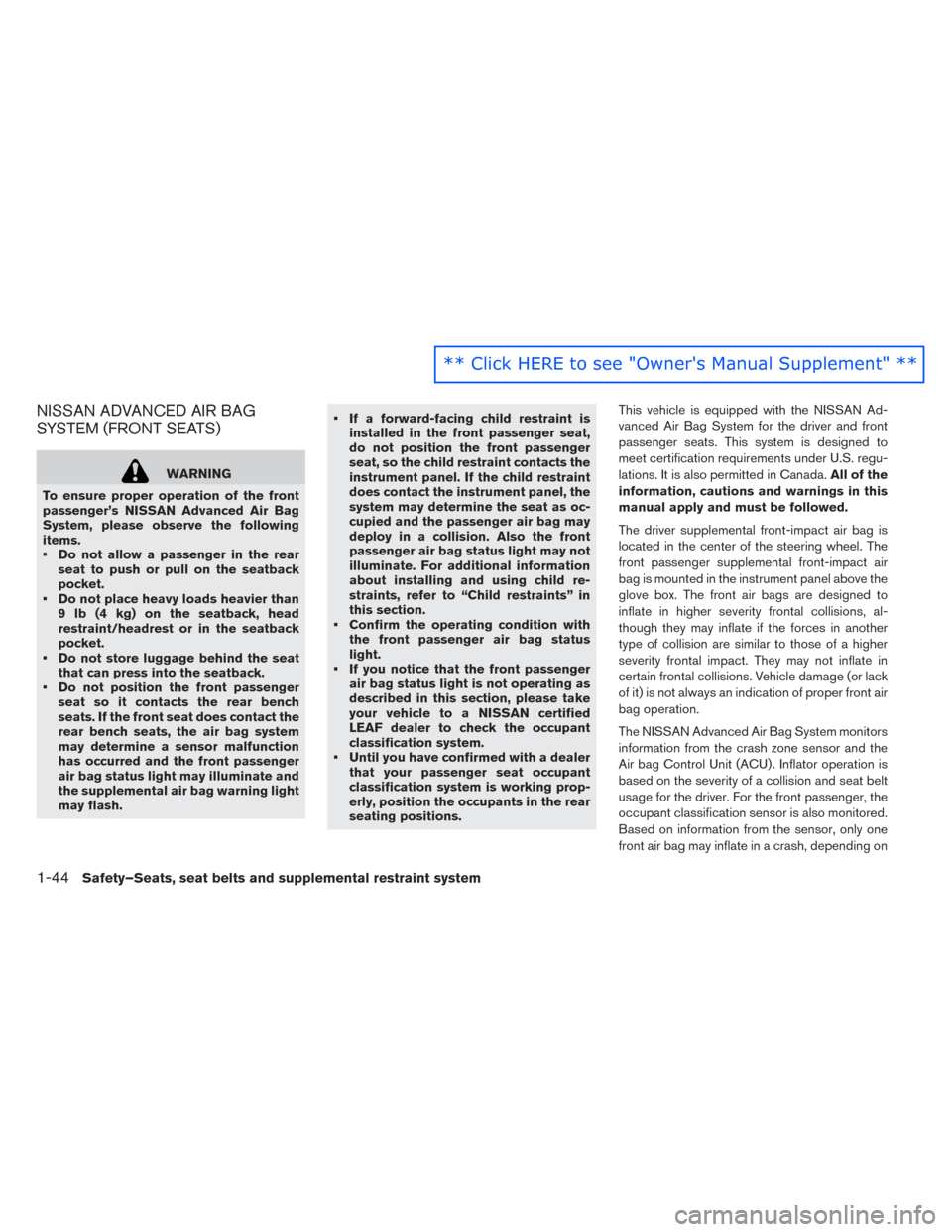
NISSAN ADVANCED AIR BAG
SYSTEM (FRONT SEATS)
WARNING
To ensure proper operation of the front
passenger’s NISSAN Advanced Air Bag
System, please observe the following
items.
• Do not allow a passenger in the rear seat to push or pull on the seatback
pocket.
• Do not place heavy loads heavier than 9 lb (4 kg) on the seatback, head
restraint/headrest or in the seatback
pocket.
• Do not store luggage behind the seat that can press into the seatback.
• Do not position the front passenger seat so it contacts the rear bench
seats. If the front seat does contact the
rear bench seats, the air bag system
may determine a sensor malfunction
has occurred and the front passenger
air bag status light may illuminate and
the supplemental air bag warning light
may flash. • If a forward-facing child restraint is
installed in the front passenger seat,
do not position the front passenger
seat, so the child restraint contacts the
instrument panel. If the child restraint
does contact the instrument panel, the
system may determine the seat as oc-
cupied and the passenger air bag may
deploy in a collision. Also the front
passenger air bag status light may not
illuminate. For additional information
about installing and using child re-
straints, refer to “Child restraints” in
this section.
• Confirm the operating condition with the front passenger air bag status
light.
• If you notice that the front passenger air bag status light is not operating as
described in this section, please take
your vehicle to a NISSAN certified
LEAF dealer to check the occupant
classification system.
• Until you have confirmed with a dealer that your passenger seat occupant
classification system is working prop-
erly, position the occupants in the rear
seating positions. This vehicle is equipped with the NISSAN Ad-
vanced Air Bag System for the driver and front
passenger seats. This system is designed to
meet certification requirements under U.S. regu-
lations. It is also permitted in Canada.
All of the
information, cautions and warnings in this
manual apply and must be followed.
The driver supplemental front-impact air bag is
located in the center of the steering wheel. The
front passenger supplemental front-impact air
bag is mounted in the instrument panel above the
glove box. The front air bags are designed to
inflate in higher severity frontal collisions, al-
though they may inflate if the forces in another
type of collision are similar to those of a higher
severity frontal impact. They may not inflate in
certain frontal collisions. Vehicle damage (or lack
of it) is not always an indication of proper front air
bag operation.
The NISSAN Advanced Air Bag System monitors
information from the crash zone sensor and the
Air bag Control Unit (ACU) . Inflator operation is
based on the severity of a collision and seat belt
usage for the driver. For the front passenger, the
occupant classification sensor is also monitored.
Based on information from the sensor, only one
front air bag may inflate in a crash, depending on
1-44Safety–Seats, seat belts and supplemental restraint system
** Click HERE to see "Owner's Manual Supplement" **